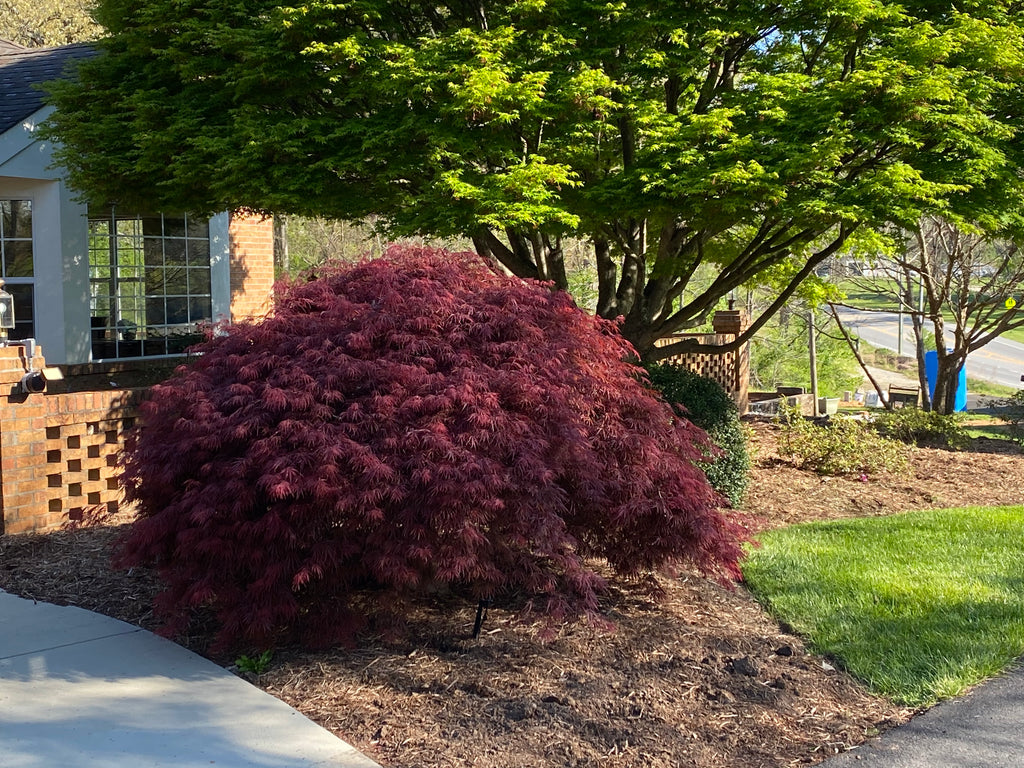

dissectum 'Green Mist' Close up of leaves David J.
Acer palmatum dissectum tamukeyama japanese maple full#
Richards CC-BY-SA 2.0 Full Form (Biltmore, NC) Jim Robbins CC BY-NC-ND 4.0 Red leaf cultivar Jeremy Cherfas CC BY-NC-ND 2.0 Green leaves Cob Lands CC-BY-SA 2.0 Flowers fresnel_chick CC BY-ND 2.0 Bark (Biltmore, NC) Jim Robbins CC BY-NC-ND 4.0 Acer palmatum var.

Tags: #weeping #purple #deciduous #small tree #water garden #specimen #slow growing #feathery leaves #showy leaves #low maintenance #fall interest #cpp #large shrub #nighttime garden #pond garden #rock garden #self-seeding #pollinator plant #Japanese garden #Asian garden #larval host plant #deciduous tree #fall color red #fall color orange #imperial moth #container plant #weed #landscape plant sleuths course #wildlife friendly 'Crimson Queen', 'Ever Red', 'Garnet', 'Green Mist', 'Inaba Shidara', 'Ornatum', 'Red Filigree Lace', 'Seiryu', 'Tamukeyama', 'Virdis', 'Waterfall' - green leaves Profile Video: See this plant in the following landscapes: Part Shade Garden Asian Garden- Zen Garden Mountain Ridge Top Garden - East Lawn and Lower Drive Border Mountain Ridge Top Garden - North Lawn and Upper Drive Border Mountain Ridge Top Garden - North Woods Mountain Ridge Top Garden - West Lawn and Border Patio Room Japanese Shade Garden Koi Pond & Water Garden Cultivars / Varieties: VIDEO created by Andy Pulte for “Landscape Plant Identification, Taxonomy and Morphology” a plant identification course offered by the Department of Plant Sciences, University of Tennessee. The Clemson Cooperative Extension Home and Garden Information Center has a factsheet on common maple diseases and insect pests.

High pH soils cause chlorosis. See potential insect and disease problem fact sheets to the left. It self-seeds easily so can spread and become weedy in the landscape. Insects, Diseases, and Other Plant Problems: Aphids, scale, maple worms, leafrollers, and leafhoppers are occasional pests. Anthracnose, leaf scorch, and frost damage, especially from late frosts, can occur. It works well as a specimen plant near a patio or entryway or planted in groups on the outskirts of a landscape or rock garden. Spring or summer pruning often results in significant bleeding. Pruning is best kept to a minimum, but if needed should be done in late fall to mid-winter. Avoid hot and dry sites and protect from strong winds. Mulch helps retain soil moisture and keep roots cool. New foliage may scorch in full sun locations in hot summer areas, particularly if soils are not kept consistently moist. Makes a good dappled shade understory plant. Plant it in full sun to partial shade but where it will get some afternoon shade. This tree prefers moist, organically rich, slightly acidic, well-drained soils and grows well in sandy loams. The size and leaf colors vary greatly with cultivars. Japanese laceleaf maple is an attractive deciduous shrub or small tree with a low spreading shape and distinctly divided lacy leaves. Acer is Latin for sharp and palmatum means shaped like a hand, referring to the leaves. Weeping as well as upright varieties exist, and the species is well noted for its beautiful deep red and orange summer color that deepens into the fall. The Japanese laceleaf maple is a short tree in the Sapindaceae (soapberry) family, native to southeast Korea and central and south Japan, and noted for having many aesthetically pleasing forms.

Phonetic Spelling AY-ser pahl-MAY-tum dis-SEK-tum Description


 0 kommentar(er)
0 kommentar(er)
